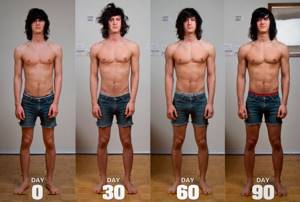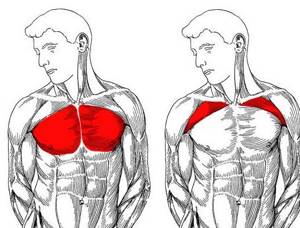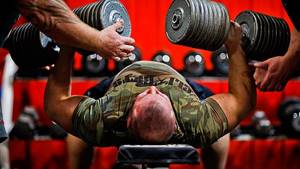If you have to choose, the three most common questions people ask about building muscle (not counting questions about how to bulk up certain body parts) are:
- How much muscle mass can you gain?
- How long does it take to get pumped up?
- How fast can you REALLY get pumped up?
More often than not, when people ask these questions, the response they get is something along the lines of, “Stop worrying about how long it will take or how fast it will happen...just shut up and go rock!” To a certain extent I understand the meaning of this answer, but more I understand why this is completely the wrong approach.
These answers are much more important than you think
Firstly, knowing the TRUTH about the speed and maximum muscle mass that, for example, can be gained in a month, you will be able to understand when the creators of various training programs, supplement manufacturers and other fitness gurus are lying to you, assuring you that you can build muscle much faster .
When you see that this is exactly what 95% of supplement manufacturers, workout program creators, and fitness experts promise every day, you will be less likely to fall for false promises.
Equally important, by understanding the actual rate and limits of muscle growth, you will have realistic expectations and will not set yourself impossible goals that will ultimately bring nothing but disappointment. Most of us (both men and women) expect to build a LOT more muscle in a FAR shorter period of time than our bodies are capable of.
men to rush from one stupid program to another, even crazier one, trying to find the one for “lightning-fast muscle growth”, which is impossible even with the use of steroids.
As a result, having not gained 5 kilograms of muscle mass in a week, which in their opinion they simply had to gain, people begin to blame it on the diet or training program and are embarrassed to change something that most likely should not have been touched (usually such changes only make things worse... “My biceps aren’t growing fast enough, which means I just need to do ten times more exercises!”).
For women, the situation is diametrically opposite. They also greatly exaggerate the expected muscle gain, BUT they do everything they can to avoid it because they don’t want to “bulk like a man.” That is why completely useless “Women’s workouts for muscle tone” appear almost every hour.
It doesn’t matter whether you are a man or a woman, you cannot achieve the desired result precisely because you do not understand what the real rate of muscle growth is and how much muscle mass you can gain in a month in the real world, and not in the world invented by the creators of advertising fitness programs. That’s why it’s time to analyze everything that will be written below and start changing right now.
What do muscles need?
To ensure consistent growth of muscle fibers, you need to know what they require in the first place. There are also several factors here:
- Recovery . It has already been proven that muscles grow faster during recovery. You cannot load the same groups every day - this will lead to overtraining. Give your body rest for 1-2 days, sleep for 8-9 hours.
- Proper nutrition . Growth requires protein, vitamins and carbohydrates. At the same time, protein is a building material for muscles, carbohydrates are a source of necessary energy, vitamins are general strengthening components that contribute to better functioning of the body, as well as optimal absorption of other elements.
- Testosterone level . The more actively the main male hormone is released in the body, the greater the results can be achieved. This pattern has been scientifically proven, which is why professional athletes make it their goal to activate testosterone production.
- Healthy lifestyle . Alcohol, cigarettes, junk food and other negative factors - all this slows down the development process. If you set serious goals for yourself, then the steps should be appropriate.
How Much Muscle Can You Gain... REALLY?
Year after year, thousands of smart people around the world never stop discussing how quickly and how many kilos you can actually gain. More than one study has been conducted on this topic.
Based on all this, over the course of your entire life you will be able to approximately gain the following amount of muscle mass (without resorting to medications):
- Average for men: about 18-22 kilograms of muscle over a lifetime;
- Average for women: about 9-12 kilograms of muscle over a lifetime.
Please note that in this case we are talking exclusively about muscles and not about weight. Of course, you can gain much more weight than muscle.
Also keep in mind that these are averages. There are always exceptions to any rule, who either cannot reach even the lower limit of the average, or easily exceed all the upper limits. This is influenced by a number of factors, so the indicators for each person will be different (we will talk about these factors a little later).
But for most people, most of the time... this is the maximum amount of muscle mass you can gain in your lifetime.

Rules for effective training
Every beginner should know how to swing correctly in the gym in order to harmoniously develop all muscles. To do this you need to follow these rules:
- Combine strength (basic, isolation) and cardio exercises.
- Change your training program regularly or add new elements to it.
- Try to pump up all muscle groups during class or train using a split system (training individual muscle groups on different days).
- Choose weights with which you can perform 10 reps (the last ones with effort).
- Select a training program based on your goals (muscle growth, increasing strength, endurance, etc.) and body type.
- Use one complex for 4-8 weeks, gradually increasing the load. It is advisable to keep a training diary.
- Before going to the gym, warm up and stretch afterward.
- Control your breathing as you perform repetitions.
- Replenish your diet with proteins, complex carbohydrates, and a small amount of healthy fats. Avoid fast food, processed foods, fried foods and other junk foods.
These are the basic recommendations, knowing which you can properly pump your body.
How long does it take to get pumped up...really?
So, we have determined the maximum possible increase in muscle mass. Next question: how long will it take?
Based on the performance of many of my clients and the clients of my colleagues, the results of a number of studies and my experience, which is more than 10 years, we can say the following.
Based on all this, the rate at which you can add muscle mass is as follows:
- Average for men: from 100 to 200 grams of muscle per week (this is about 0.5-1 kilogram per month);
- Average for men: from 50 to 100 grams of muscle per week (this is about 200-500 grams per month).
Again, this is pure muscle mass, not weight. In addition to muscle, the weight gained in a week can include (and most often does) fat, water and glycogen. But here we are talking exclusively about muscles.
And frankly, this rate of muscle growth is what you would expect under ideal conditions. That is, the ideal ratio of training and nutrients in the diet, the ideal amount of sleep every day, the ideal time for rest and recovery, the absence of stress and much more. Simply put, the closer your lifestyle is to this ideal, the faster you gain muscle mass (until you hit the ceiling described above).
And again... these are averages. Some people build muscle faster (rarely), others never reach that speed (the most common state of affairs). The exact amount of muscle mass and the rate of its gain per week, month, year depends on a number of individual factors. Speaking of factors, let's figure out what affects muscle growth.

From beginner to professional in 4 stages
The issue of training needs to be approached thoroughly, but first you need to understand the peculiarities of how the body works. The good news is that absolutely anyone can pump up, regardless of their initial parameters. The only difference is how much time it takes to get the desired result.
A person with an asthenic physique will have to become closely acquainted with sports supplements, and in some cases they cannot do without anabolic steroids, of course, if we are talking about professional sports. The advantage in this case is that you can start training to gain muscle mass almost immediately. But a man with a lot of excess weight is less fortunate - he will first have to lose kilos, then make efforts for several months to maintain what he has achieved, and only after his body gets used to it, move on to intensive training to gain weight. This is true for women too.
The path “from beginner to muscleman” will consist of four stages:
- preparation of the body;
- muscle hypertrophy;
- muscle hyperplasia;
- adaptation to maintain what has been achieved.
If we are talking about a person with significant excess weight, two more points are added to this list - weight loss and adaptation.
Adaptation after weight loss should be discussed in more detail. If you are overweight, the body begins to work differently, of course, if we are talking about significant fat deposits - 20 kg or more. To maintain vital functions with such an additional load, adaptive processes are launched, as a result of which the heart rate, blood pressure, respiratory rate and other indicators change. Losing weight is only possible with proper nutrition with a calorie deficit and intense training with an emphasis on basic multi-joint exercises. After eliminating excess weight, the body works according to the “old scheme” for 3-4 months, because adaptive mechanisms have already been established. Accordingly, in a person who has lost weight, all processes are “sharpened” to greater weight, to which the body has long been accustomed. To “reconfigure” it is necessary to continue living in the same regime aimed at losing weight for at least 90 days after achieving the goal. The main emphasis is on diet, calorie intake and regular training. The human body is quite lazy, so it’s easier for it to put off excess weight again than to “reconfigure”, so in the first three months after losing weight, it will strive to return to its previous shape, intensively storing fat. If during this period you switch to a diet designed to gain muscle mass, a person will get the opposite effect and simply gain extra pounds, despite training.
Preparing the body
The first stage that absolutely every beginning athlete goes through is preparation. It consists in increasing overall performance and getting the muscles used to the load. This period lasts about 100 days - this is exactly the period the body needs to make the muscles work effectively.
When starting classes, you need to focus on basic multi-joint exercises, including weights. The advantage of this approach is the rapid development of the body. It’s interesting that literally after the third workout a beginner will already see real results, and at the end of the second month a noticeable weight gain is possible - plus 2-3 kg.
The preparatory stage launches important mechanisms without which hypertrophy is impossible. This happens as follows.
The human body is quite lazy and does not like to experience stress. The first workout will be the hardest, because the body is subjected to enormous stress and spends a lot of energy. The central nervous system perceives this as the “beginning of the end”, as a result, mechanisms are launched that allow you to take on more weight with less energy consumption. During training, glycogen is actively released, but adaptive mechanisms are activated, and during moments of rest from exercise, the body tries to store this polysaccharide as much as possible. The result of these complex processes is the coordinated work of muscle fibers. As a result, over time, less energy is spent on the training process, and overall endurance and strength increase.
Don’t delude yourself that it will always be like this – this is just the first step towards the body of your dreams. After about 100 days, the preparation stage is completed, the body gets used to the changed loads. If at first there is fairly rapid progress, muscles grow, weight increases, then after three months these processes slow down. And in fact, this is a good sign: the efficiency and coherence of the fibers has increased, which means the possibility of hypertrophy has opened up.
Muscle hypertrophy
Hypertrophy is an increase in the volume and mass of skeletal muscles. It is through this process that it is possible to pump up voluminous biceps and increase shoulder width. Conditions necessary for effective hypertrophy:
- good general endurance and completed preparatory training phase;
- regular and balanced loads;
- properly composed diet;
- rest.
There are several hypotheses explaining the cause of skeletal muscle hypertrophy. This process is the body's response to increased stress. According to one theory, during strength exercises, muscle fibers rupture due to high tension and hypoxia. These processes trigger active protein synthesis, which is spent on strengthening the fibers. During this period, it is very important for the body to receive all the necessary macronutrients, so diet plays a vital role. To increase muscle mass, you need easily digestible protein, which can be obtained from foods or sports nutrition.
The second important nuance is the alternation of load and rest. Too much training won't do you any good. It is best to exercise every other day so that the body has time to recover.
The good news is that muscles gain maximum volume in 24 months. Thus, from the end of the preparatory stage to the receipt of the final form that a particular organism is capable of, no more than two years of regular training will pass. During preparation, it is possible to gain about 2-3 kg of muscle mass, in the first year of active hypertrophy - 15-17 kg, in the second year - no more than 10-12 kg. The data is given for a man of average height and without excess weight. It is assumed that the person got rid of excess weight, if any, before the hypertrophy stage began.
The bad news is that after two years, progress slows down. There are two options here - either accept it and train to stay in shape, or move on to the next stage.
Muscular hyperplasia
Hyperplasia is the growth of tissue; in bodybuilding, this term refers to the process of dividing muscle fibers. It should not be confused with hypertrophy - with it the fibers thicken, but their number does not change. With hyperplasia, the fibers become larger due to the division of existing ones.
An important fact: the number of muscle fibers a person has is determined by genetics. During life, their number does not change, but they can decrease or increase in volume. With hyperplasia, everything is also not so simple, although this topic is widely discussed in the circles of professional athletes. According to some data, this process does not have a significant effect on muscle size, as it increases the number of fibers by no more than 5%. Also, the possibility of dividing muscle fibers in humans during strength training to the limit of capabilities has not been proven.
Today, there are two options for stimulating hyperplasia - high-volume training with low weight or taking advances in sports pharmacology. High-volume training is a high-repetition exercise, all exercises are performed 15 times, the weight used is 60-70% of the maximum the athlete can train with. The key point is minimal rest between sets (no more than 60 seconds).
Many athletes resort to the pharmacological method of stimulating muscle hyperplasia, but it has many contraindications.
Adaptation stage
The last stage does not take much part in the formation of a strong and pumped up body, but is an important component of the training process of professional athletes. It consists of forcing the body to work to its limit, “pumping” the cardiovascular, lymphatic and nervous systems. This is achieved through functional training and intense aerobic exercise. The disadvantage of this method is that the body gets used to it over time. An example of this is professional squash players or tennis players, who during cardio training cannot raise their heart rate above 150 beats per minute, since the cardiovascular system is simply accustomed to such loads.
The adaptation stage has no deadline. Most often, bodybuilders resort to such exercises during preparation for competitions, which becomes part of the cutting program.
The right pain

Unpleasant sensations in the muscles arise due to the decomposition of protein substances into lactic acid, which causes pain, burning and a feeling of inflammation inside the muscles.
Mild pain the day after training is inevitable and is even a sign of good muscle function.
To make the unpleasant sensations go away quickly, you can take a contrast shower, a warm bath with aromatic oils, or thoroughly stretch your muscles in a yoga or Pilates class.
It is also recommended to book a massage to relieve pain and remove muscle blocks.
Horizontal barbell press
The bench press is a basic exercise that, in addition to the pectoral muscles, actively works the triceps and anterior deltoids. It is performed at the beginning of training, when the athlete is still full of strength and energy.
Technique:
- Lie down on a horizontal bench so that the bar is at eye level. Grab the barbell with a wide grip. Remove the projectile from the racks (by yourself or with the help of a partner).
- While inhaling, slowly lower the barbell down. The bar should touch the middle or lower chest.
- As you exhale, press the barbell up with a powerful movement.
- Repeat the movement as many times as necessary.

Anatomy
Exercise and frequency of training is, of course, a very important topic, but first it would not hurt to understand the anatomy of the muscle group discussed in the article.
The chest is divided into two muscles:
- Pectoralis major muscle. This is the name given to the fan-shaped muscle, which is located in front of the chest. The pectoralis major muscle begins on the pectoral bone in the center of the chest and attaches to the humerus near the shoulder joint. Its main function is to flex the humerus toward the chest.
- Pectoralis minor muscle. This muscle is located under the pectoralis major muscle. It begins approximately in the middle of the chest and is attached to the coracoid process of the scapula. The main function of this muscle is to move the shoulder forward.
The serratus anterior is located below the level of the pectoralis major and minor muscles.
In addition, the pectoral muscles can be divided into three bundles: upper, middle and lower.
Well, we've sorted out the theory, now let's move on to practice. Let's start by discussing the most popular chest exercises in the gym.

Tips and tricks
Here are some helpful tips to make your workouts more effective and safer:
- Warm up well before each training session. This doesn't just apply to chest training, this applies to all workouts in general;
- During the bench press, use the help of a partner so that he can give you heavy weight and in case of emergency;
- Do each exercise as technically as possible. The effectiveness of these very exercises depends on your technique.
How many times a week should you pump your breasts? We think we have managed to answer this question. We hope that the information provided in this article was useful to you.
Lifting with dumbbells lying down
Flying with dumbbells in a lying position is aimed at isolated chest work. It is usually performed at the end of the workout. The main advantage of the fly is that it puts a shock load on the chest and excludes the triceps and other third-party muscles from the work as much as possible.
Technique:
- Lie on the floor (it is advisable to lay a special mat), pick up dumbbells and lift them in front of you.
- As you inhale, smoothly spread your arms until your elbows touch the floor. Your arms should be slightly bent at the elbow joints. Don't bend them too much so that the pinch does not automatically turn into a dumbbell press.
- As you exhale, bring your arms together in front of you.
- Do the required number of repetitions.

Horizontal Dumbbell Press
The main advantage of dumbbells is that they can be used alternately. In this way, the athlete can not only correct the imbalance, but also force the pectoral muscles to work interconnectedly, bringing the arms together at the top point to achieve maximum contraction.
The technique of performing a dumbbell press is in many ways similar to the technique of a barbell press:
- Grab some dumbbells (by yourself or with the help of a partner) and lie down on a bench. The projectiles should be at the level of your chest.
- As you exhale, press the dumbbells up toward your center. At the top point, do not extend your arms completely to maintain tension in the muscles. Don't let the projectiles touch.
- As you inhale, gently lower the dumbbells to the starting position.
- Do as many repetitions as you need.

Main conclusions
To swing properly in the gym, you need to follow these recommendations:
- Choose a training program based on your goals and body type.
- Combine basic, isolation exercises, as well as cardio.
- Train your entire body evenly.
- Exercise no more than 3 times a week with breaks of 2 days.
- Hone your technique, and then gradually increase the load.
- Don't forget to warm up and cool down to avoid injury.
- Change your training program regularly.
- Eat right.
- Take sports nutrition only after consulting a specialist.
By following these rules, you can achieve impressive results in just 3 months. The muscles will become more voluminous, stronger, and the body will become more prominent.










